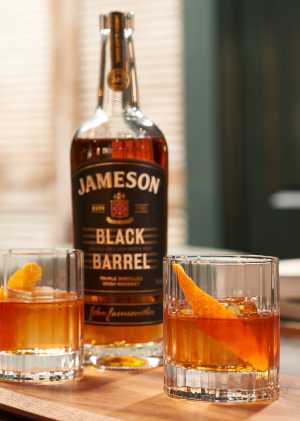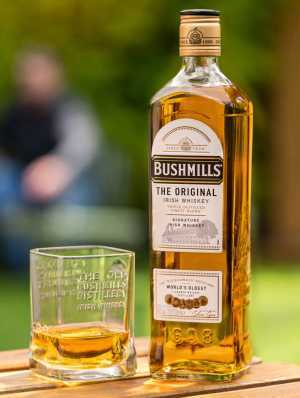Across the centuries, Ireland and Scotland have had more than their share of bitter disputes. But today, one of the fiercest contests between these brothers of the British Isles can be found at the bottom of a glass — and not in the way you might think.
For the last few years, Irish whiskey (more on that spelling later) has been slowly creeping into the consciousness of seasoned dram drinkers, growing in popularity across the world and particularly in Canada. Scotch — so esteemed, it dropped the whisky somewhere along the way — has long epitomized the best of the best in its category. But now, thanks to its quality, innovative expressions, Irish whisky is looking to throw off the shackles of its younger sibling reputation. In the years from 2017 to 2020, Irish whisky sales in Canada increased by 66 per cent to over four million bottles. Alongside socks and golf balls, scotch is perhaps the most popular Father’s Day gift — but with so many interesting, award-winning Irish spirits on offer, dad might be getting a different brown liquor next year.
“The Scotch whisky industry can say they invented it all by themselves, but our whisky predates theirs by 400 years,” says James Kilgannon, Teeling Whiskey Distillery’s Brand Ambassador. He’s not being salty. Ireland really is the home of whisky, dating its distilling back to Irish monks who travelled to Arabia between 500 and 600 AD. Having produced the spirit for longer than anywhere else (Ireland once boasted 70 per cent of the world’s production), Irish whisky has a depth and diversity that’s unrivalled.
But despite Ireland ruling the whisky world in the Victorian era, the 1860 Spirits Act — which allowed grain whisky and single malts to be blended — gave Scotland the opportunity to create a cheaper product, eating into Ireland’s global share. In the 19th century, Ireland added an 'e' to its spelling (‘whiskey’) to differentiate from Scottish competitors using grain whisky in blends — befuddling copy editors in the process (for the record, we at foodism spell whisky without the 'e').
Guinness might be the best known brown liquid to come out of Dublin, but the city’s been producing some of the world’s most exciting spirits of late. Teeling was the first new distillery to open in Dublin in over 125 years, just down the road from where the original family distillery first stood in 1782. “We opened in 2015 and were the only ones to operate,” says Kilgannon. The move was so pioneering, Teeling actually had to teach Dublin City Council how to build a whisky distillery.
“People thought it was mad because if you’re looking to build a whisky distillery, you build it in the countryside, not one of the world’s most expensive cities,” says Kilgannon. “But we wanted to revive Dublin distilling.” And revive they did: Roe & Co, The Dublin Liberties Distillery and several others moved in shortly after, creating a distilling centre, all within 10 minutes of one another. “This resurgence of craft distilleries is nice — and it smells good,” laughs Kilgannon.
It’s not the first time the brand has made bold strides. In the 1980s, brothers John, Jack and Steve Teeling opened Cooley Distillery, becoming Ireland’s first independent distillery and breaking the monopoly on Irish whisky. It seems success is in the company’s DNA — in the six years since opening in Dublin, Teeling Whiskey Distillery has won over 300 awards and welcomed more than half a million visitors to their facility.
Teeling Whiskey Distillery was the first new distillery to open in Dublin in over 125 years
Comparison may be the thief of joy, but it’s important to know how whisky making varies between Celts. For starters, Irish whisky is typically distilled three times compared to scotch’s two, leading to a mellower and less smoky taste than its counterpart. “People do like a bit more of a smooth product these days... But just because something is smooth doesn’t mean it can’t have big, dominant flavours,” says Kilgannon.
There are also stricter regulations in Scotland on what constitutes a barrel, specifying that whisky must be aged in oak. Comparatively, The Irish Whiskey Act of 1980 states that all Irish whisky must be aged for at least three years in wooden casks, leaving the door open to interpretation and a whole lot of fun. Everything from bourbon, sherry, port, acacia and madeira casks are used in the aging process, allowing for plenty of experimentation — in other words, a bartender’s dream.
“I remember we did a variation on the Tipperary (a classic cocktail made with Irish whisky) for a cigar pairing,” says Alfred Siu of Toronto’s Project Gigglewater. “We made it with Teeling’s Single Malt, Martini Rosso, Green Chartreuse and chocolate bitters.”
Inside Project Gigglewater in Toronto
Siu admits that customers, for the most part, simply gravitate towards scotch because it’s more popular. So, it’s up to him to illuminate guests on the depth and breadth of fantastic Irish whiskies, outside the famous brands. Redbreast and Green Spot are great examples — as is the delightfully named Writers’ Tears.
“It’s a no-brainer when recommending great whisky, especially to people who haven’t delved deep yet,” says Rebecca Felgate, a digital content creator and cocktail enthusiast. “Writers’ Tears Copper Pot is packed with flavour, but not super overpowering or smoky like, say, an Islay scotch. There’s a very subtle sweetness and fruity notes that blend well with citrus, a staple cocktail ingredient. It’s exceptionally good in a punchy, ice-cold paper plane, but, testimony to its versatility, tastes just as great when blended with spice in a hot toddy.”
As the taste for Irish whisky continues to grow around the world, so too do the international collaborations. “I can’t wait to try their Inniskillin Ice Wine barrel-aged whisky when it’s released,” says Felgate. “Canada meets Ireland — I am excited!”
Kilgannon encourages me to look beyond the classic cocktails when shaking up Irish whisky. “Our flagship whisky [Teeling Small Batch] is a blend, and that Central American rum maturation on it really makes it a lot more flexible to use in cocktails. It opens up the world to Tiki-style cocktails — maybe a Zombie — because of that warmth that you don’t get as much of in a rum.”
Over at Jameson, drams are distilled in both sherry barrels and bourbon barrels giving the whisky a balance of sweetness, plus dry fruit notes like sultanas, raisins and a little nuttiness. “The caramel flavours from the barrel, that’s really the quintessential style of Irish whisky,” says Katherine Condon, chemical engineer and distiller at Irish Distillers, which counts Jameson, Redbreast and Midleton among its whisky portfolio. “It’s a mixture of your pot stills — they allow for that spicy, robust, full-bodied element of your spirit, which is then paired with your lighter style from our green column stills. That imparts more of a delicate, floral note.”
Our column stills impart a delicate, floral note
No one has played its part in the Irish whisky boom more than Jameson, which accounts for 70 per cent of Irish whisky sales. But, just to make the rivalry even more contentious, founder John Jameson was actually a Scot who launched the eponymous distillery in Dublin in 1780.
Irish Distillers’ Midleton Distillery in County Cork
“There are lots of distilleries opening up, which is brilliant, but the only way we can drive this category forward is through innovation, while still holding on to our roots,” says Condon.
For Jameson Black Barrel, the barrels are double charred (hence the name), setting them alight a second time to expose more of the wood and impart a chocolatey flavour. Elsewhere, their Caskmates series ages their whisky in IPA and stout barrels for a unique taste.
“We lend our barrels to local breweries in Ireland, and we’ve actually collaborated with over 65 breweries around the globe,” says Condon. “It’s a symbiotic relationship.”
So why has Irish whisky, with all of its rich history, played second fiddle to the synonymous scotch? It seems that despite the luck of the Irish, the Emerald Isle has suffered its fair share of setbacks.
“You had a prohibition in the 1920s, then you had the Trade War with Britain,” says Condon. “At that time, over 70 per cent of the population took the pledge to abstain from alcohol. Then of course, you had the famine, which didn’t help.”
Katherine Condon, chemical engineer and distiller at Irish Distillers
Had this series of events not taken place, we might be drinking ‘Irish’ and talking about the Scotch whisky boom. But as it transpired, in 1966, the three remaining distilleries — Jameson, Powers and Cork — were forced to pool their resources, becoming Irish Distillers in a bid to reverse Irish whisky’s decline. Given that Irish whisky has been the fastest growing spirit since 1990, we think they might have cracked it.
Bushmills — the oldest distillery in the world — later followed suit, joining Irish Distillers in 1972. Located in Co. Antrim, Northern Ireland, Bushmills has been distilling whisky since King James gave them a licence in 1608. The distillery hangs its hat on being a primarily single malt distiller, something of a rarity in its field.
Bushmills is the oldest distillery in the world
“Back in the 1800s, there was a tax on malted barley, so a lot of distilleries opted to switch to un-malted barley to avoid paying the tax,” explains brand manager, Giampiero Isabella. “Bushmills was the only distiller in Ireland to stick to their guns and continue to use malted barley. In order to be a single malt distiller, it has to be malted barley that is produced all in one facility. It’s a grain-to-glass distillery, so everything is produced onsite at Bushmills using locally-sourced ingredients from Ireland.”
Bushmills, in Co. Antrim, Northern Ireland, is the oldest distillery in the world, receiving a licence from King James in 1608
Despite being steeped in history, Bushmills is anything but old-fashioned. Master blender Helen Mulholland was the first woman to be inducted into the International Whisky Magazine Hall of Fame and is the first woman to have received the Chairman’s Award for her outstanding contribution to the development of the Irish whisky industry.
Isabella believes that this premiumization of the spirit, alongside a resurgence of cocktail culture, has cemented Irish whisky in people’s hearts. “I think there’s a bit of fatigue with respect to scotch. So people are starting to explore beyond that.”
Once equated with quantity-over-quality drinking, Ireland is putting its party culture in the rearview mirror and producing some of the world’s most exciting whisky. From single malts savoured to tropical Tiki tipples, more and more people are saying sláinte and enjoying the Irish whisky renaissance.
“A good scotch or a silky bourbon is well-trodden ground,” explains Felgate. “But now Ireland is gaining the recognition it deserves. The triple distillation makes for a smooth drinking experience and, truly, I think the surge in popularity has something to do with how long we’ve all spent locked indoors. I have certainly been dreaming of emerald plains oozing with myth and legend. If you can’t get me to Ireland, at least get me something Irish in my glass.”


